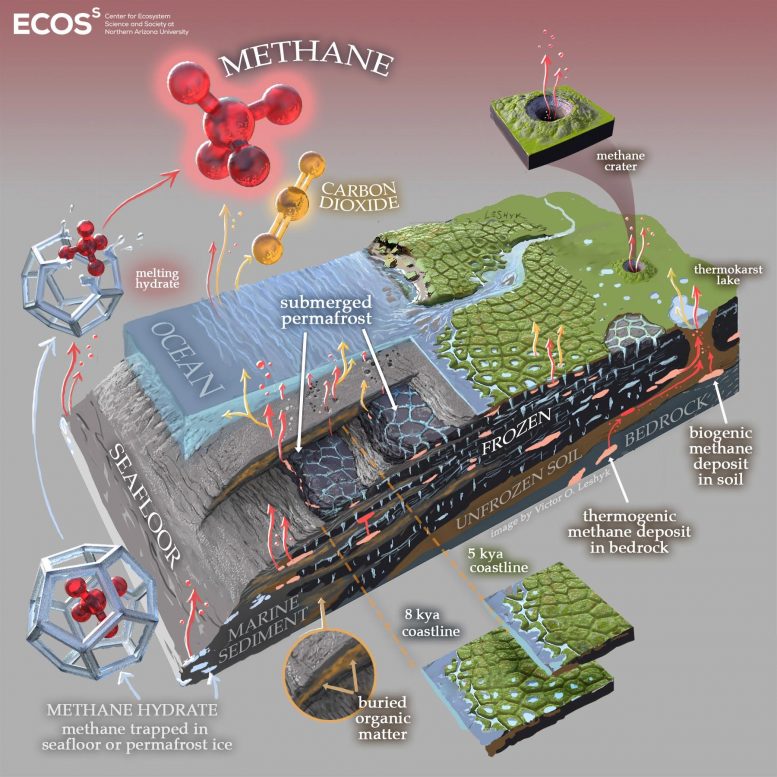International Research Team Begins Uncovering Mystery Lurking Beneath the Arctic Ocean
4 Years, 1 Month, 2 Weeks, 6 Days, 29 Minutes ago

A high-intensity accelerator beam is formed of trillions of particles that race at lightning speeds down a system of powerful magnets and high-energy superconductors. Calculating the physics of the beam is so complex that not even the fastest supercomputers can keep up.
However, a milestone achievement by accelerator physicists at the Department of Energy’s (DOE’s) Oak Ridge National Laboratory (ORNL) has enabled beam characterizations to be studied in extraordinary new detail. They used a newly developed measurement technique to better understand beam loss—stray particles that travel outside the confinement fields of the accelerator. Mitigating beam loss is paramount to realizing more powerful accelerators at smaller scales and lower costs.
“It’s a problem that’s been haunting us for more than 20 years,” said ORNL accelerator physicist Alexander Aleksandrov. “Beam loss is probably the biggest issue for high-intensity accelerators, like the Large Hadron Collider at CERN and the Spallation Neutron Source (SNS) here at Oak Ridge.”
Operating at 1.4 megawatts, SNS is one of DOE’s flagship research facilities that leverages neutrons to study energy and materials at the atomic scale. Neutrons are created at SNS by propelling bunches, or pulses, of protons at almost 90 percent the speed of light down the facility’s linear accelerator—or linac. At the end of the linac, the proton beam pulses smash into a metal target vessel filled with swirling liquid mercury at a rate of 60 times a second.
The atomic collisions create spalls of neutrons—about 20 neutrons per proton. The neutrons then fly through energy moderators and vacuum chambers to surrounding instruments where scientists use them to study how a material’s atoms are arranged and how they behave. Essentially, increasing the accelerator power increases the number of neutrons created, which in turn increases the facility’s scientific productivity and enables new types of experiments.
“Ideally, we want all the particles in the beam to be concentrated into a single, very compact cloud. When particles stray away, they form low-density clouds, called a beam halo. If the halo gets too big and touches the walls of the accelerator, that results in beam loss and can create radiation effects and other problems,” said Aleksandrov.
Instead of making the measurements at SNS, the team used a replica of the SNS linac at ORNL’s Beam Test Facility. Using a replica enables researchers to conduct advanced physics studies on the accelerator without interrupting experiments at the actual neutron production facility.
The advanced measurement technique is based on the same approach the researchers used in 2018 to make the first particle accelerator beam measurement in six dimensions. Whereas 3D space includes points on the x, y, and z axes to measure position, 6D space has three additional coordinates to measure a particle’s angle, or trajectory.
“The technique is actually quite simple. We take a block of material with a number of slits that we use to cut out small samples of the beam. That provides us with a beamlet containing a smaller, more manageable number of particles that we can measure, and we can move that block around to measure other sections of the beam,” said Aleksandrov.
The beam samples were extracted from one of the linac’s primary accelerating components called the medium energy beam transport line, or MEBT. The replica MEBT, around 4 meters long, includes a beam scraper to reduce early beam halo and provides more space than typical MEBTs for other diagnostic tools.
“But, instead of cutting out 6D phase space, this time we only cut out samples in two-dimensional phase space,” he said. “Basically, if you can measure in six dimensions with reasonable resolution, then you can measure in lower dimensions with much higher resolution.”
Using the 6D measurements as a baseline approach, measuring in 2D unlocked a radically improved level of resolution of 1 part per million. One part per million is significant to modern accelerators for two reasons, according to Aleksandrov. It is the maximum allowable density at which beam halo is manageable, and it is the level of resolution, or dynamic range, necessary to validate and build more accurate computer modeling simulations of the beam halo effect.
“In the past, beam modeling at this level was kind of an impossible task because computers were not capable of calculating billions of particles; and now they can, but it can’t be done accurately without these initial beam distributions,” said Kiersten Ruisard, a Clifford G. Shull postdoctoral research fellow at ORNL. “There is no model that we know of that predicts the beam loss patterns that are measured in the real accelerator. Testing our models with this unprecedented level of precision is necessary to build more robust simulations that will help us mitigate these losses.”
Measuring the beam at a relatively low energy of 2.5 megaelectronvolts provided the researchers with insights into how to model the beam at higher energies. Aleksandrov said they are already working on the next technique improvement, which will involve using lasers to measure the beam at a significantly higher energy of 1 gigaelectronvolt. That upgrade is a few years out.
The team’s research results are published in the scientific journal Nuclear Instruments & Methods in Physics Research. In addition to Aleksandrov, Cousineau, and Ruisard, the paper’s authors include ORNL’s Alexander Zhukov.
“Although we could make 100 megawatt-class accelerators now, it’s just not practical. They would be too big and too expensive,” said physicist Sarah Cousineau, the science and technology section head in ORNL’s Research Accelerator Division. “Improving the resolution of the measurement to higher levels not only allows us to make progress in understanding and simulating beam halo, but it also advances our understanding of how to make accelerators more powerful, at smaller scales, and at much more reasonable costs.”